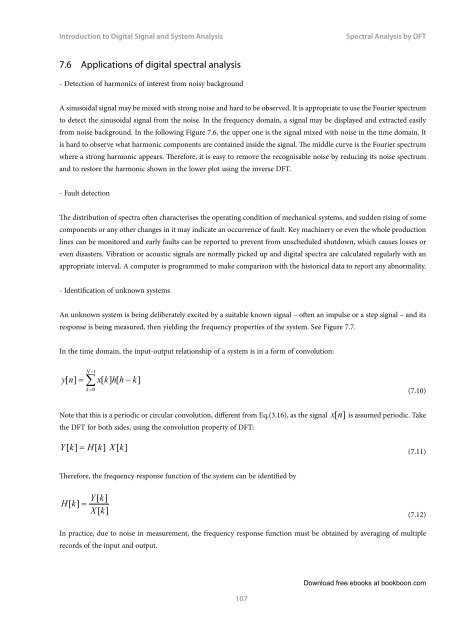Introduction to Digital Signal and System Analysis - Tutorsindia
Introduction to Digital Signal and System Analysis - Tutorsindia
Introduction to Digital Signal and System Analysis - Tutorsindia
You also want an ePaper? Increase the reach of your titles
YUMPU automatically turns print PDFs into web optimized ePapers that Google loves.
<strong>Introduction</strong> <strong>to</strong> <strong>Digital</strong> <strong>Signal</strong> <strong>and</strong> <strong>System</strong> <strong>Analysis</strong><br />
Spectral <strong>Analysis</strong> by DFT<br />
7.6 Applications of digital spectral analysis<br />
- Detection of harmonics of interest from noisy background<br />
A sinusoidal signal may be mixed with strong noise <strong>and</strong> hard <strong>to</strong> be observed. It is appropriate <strong>to</strong> use the Fourier spectrum<br />
<strong>to</strong> detect the sinusoidal signal from the noise. In the frequency domain, a signal may be displayed <strong>and</strong> extracted easily<br />
from noise background. In the following Figure 7.6, the upper one is the signal mixed with noise in the time domain. It<br />
is hard <strong>to</strong> observe what harmonic components are contained inside the signal. The middle curve is the Fourier spectrum<br />
where a strong harmonic appears. Therefore, it is easy <strong>to</strong> remove the recognisable noise by reducing its noise spectrum<br />
<strong>and</strong> <strong>to</strong> res<strong>to</strong>re the harmonic shown in the lower plot using the inverse DFT.<br />
- Fault detection<br />
The distribution of spectra often characterises the operating condition of mechanical systems, <strong>and</strong> sudden rising of some<br />
components or any other changes in it may indicate an occurrence of fault. Key machinery or even the whole production<br />
lines can be moni<strong>to</strong>red <strong>and</strong> early faults can be reported <strong>to</strong> prevent from unscheduled shutdown, which causes losses or<br />
even disasters. Vibration or acoustic signals are normally picked up <strong>and</strong> digital spectra are calculated regularly with an<br />
appropriate interval. A computer is programmed <strong>to</strong> make comparison with the his<strong>to</strong>rical data <strong>to</strong> report any abnormality.<br />
- Identification of unknown systems<br />
An unknown system is being deliberately excited by a suitable known signal – often an impulse or a step signal – <strong>and</strong> its<br />
response is being measured, then yielding the frequency properties of the system. See Figure 7.7.<br />
In the time domain, the input-output relationship of a system is in a form of convolution:<br />
y[<br />
n]<br />
=<br />
N<br />
∑ − 1<br />
k = 0<br />
x[<br />
k]<br />
h[<br />
h − k]<br />
(7.10)<br />
Note that this is a periodic or circular convolution, different from Eq.(3.16), as the signal x [n]<br />
is assumed periodic. Take<br />
the DFT for both sides, using the convolution property of DFT:<br />
Y [ k]<br />
= H[<br />
k]<br />
X [ k]<br />
(7.11)<br />
Therefore, the frequency response function of the system can be identified by<br />
H [ k]<br />
=<br />
Y[<br />
k]<br />
X [ k]<br />
(7.12)<br />
In practice, due <strong>to</strong> noise in measurement, the frequency response function must be obtained by averaging of multiple<br />
records of the input <strong>and</strong> output.<br />
107<br />
Download free ebooks at bookboon.com
















